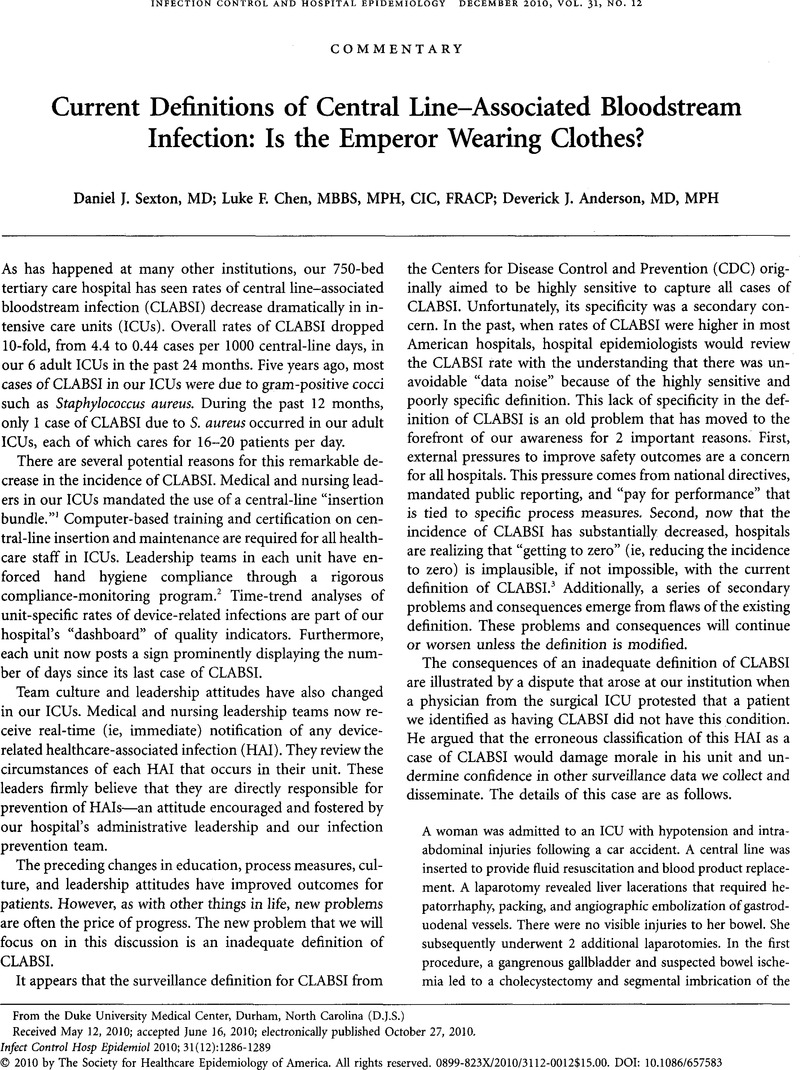Crossref Citations
This article has been cited by the following publications. This list is generated based on data provided by Crossref.
Cheng, Allen C
Bass, Pauline
Scheinkestel, Carlos
and
Leong, Tim
2011.
Public reporting of infection rates as quality indicators.
Medical Journal of Australia,
Vol. 195,
Issue. 6,
p.
326.
Passaretti, C. L.
Barclay, P.
Pronovost, P.
and
Perl, T. M.
2011.
Public Reporting of Health Care–Associated Infections (HAIs): Approach to Choosing HAI Measures.
Infection Control & Hospital Epidemiology,
Vol. 32,
Issue. 8,
p.
768.
Fraser, T. G.
and
Gordon, S. M.
2011.
CLABSI Rates in Immunocompromised Patients: A Valuable Patient Centered Outcome?.
Clinical Infectious Diseases,
Vol. 52,
Issue. 12,
p.
1446.
White, Joan T.
and
Fraimow, Henry
2011.
Consistency versus Accuracy in Reporting Central Line-Associated Bloodstream Infections.
Infection Control & Hospital Epidemiology,
Vol. 32,
Issue. 5,
p.
519.
Fridkin, Scott K.
and
Olmsted, Russell N.
2011.
Meaningful measure of performance: A foundation built on valid, reproducible findings from surveillance of health care-associated infections.
American Journal of Infection Control,
Vol. 39,
Issue. 2,
p.
87.
Mayer, J.
Greene, T.
Howell, J.
Ying, J.
Rubin, M. A.
Trick, W. E.
and
Samore, M. H.
2012.
Agreement in Classifying Bloodstream Infections Among Multiple Reviewers Conducting Surveillance.
Clinical Infectious Diseases,
Vol. 55,
Issue. 3,
p.
364.
Sexton, Daniel J.
Chen, Luke F.
Moehring, Rebekah
Thacker, Paul A.
and
Anderson, Deverick J.
2012.
Casablanca Redux: We Are Shocked That Public Reporting of Rates of Central Line–Associated Bloodstream Infections Are Inaccurate.
Infection Control & Hospital Epidemiology,
Vol. 33,
Issue. 9,
p.
932.
DIXON‐WOODS, MARY
LESLIE, MYLES
BION, JULIAN
and
TARRANT, CAROLYN
2012.
What Counts? An Ethnographic Study of Infection Data Reported to a Patient Safety Program.
The Milbank Quarterly,
Vol. 90,
Issue. 3,
p.
548.
Oh, John Y.
Cunningham, Margaret C.
Beldavs, Zintars G.
Tujo, Jennifer
Moore, Stephen W.
Thomas, Ann R.
and
Cieslak, Paul R.
2012.
Statewide Validation of Hospital-Reported Central Line–Associated Bloodstream Infections: Oregon, 2009.
Infection Control & Hospital Epidemiology,
Vol. 33,
Issue. 5,
p.
439.
Sheps, Sam
and
Black, Bernard
2012.
Public reporting of HAI rates.
Clinical Governance: An International Journal,
Vol. 17,
Issue. 2,
p.
124.
Beekmann, Susan E.
Diekema, Daniel J.
Huskins, W. Charles
Herwaldt, Loreen
Boyce, John M.
Sherertz, Robert J.
and
Polgreen, Philip M.
2012.
Diagnosing and Reporting of Central Line–Associated Bloodstream Infections.
Infection Control & Hospital Epidemiology,
Vol. 33,
Issue. 9,
p.
875.
Shah, Harshal
Bosch, Wendelyn
Thompson, Kristine M.
and
Hellinger, Walter C.
2013.
Intravascular Catheter-Related Bloodstream Infection.
The Neurohospitalist,
Vol. 3,
Issue. 3,
p.
144.
Bion, Julian
Richardson, Annette
Hibbert, Peter
Beer, Jeanette
Abrusci, Tracy
McCutcheon, Martin
Cassidy, Jane
Eddleston, Jane
Gunning, Kevin
Bellingan, Geoff
Patten, Mark
and
Harrison, David
2013.
‘Matching Michigan’: a 2-year stepped interventional programme to minimise central venous catheter-blood stream infections in intensive care units in England.
BMJ Quality & Safety,
Vol. 22,
Issue. 2,
p.
110.
Moehring, Rebekah W.
Staheli, Russell
Miller, Becky A.
Chen, Luke Francis
Sexton, Daniel John
and
Anderson, Deverick John
2013.
Central Line-Associated Infections as Defined by the Centers for Medicare and Medicaid Services' Hospital-Acquired Condition versus Standard Infection Control Surveillance Why Hospital Compare Seems Conflicted.
Infection Control & Hospital Epidemiology,
Vol. 34,
Issue. 3,
p.
238.
See, Isaac
Iwamoto, Martha
Allen-Bridson, Kathy
Horan, Teresa
Magill, Shelley S.
and
Thompson, Nicola D.
2013.
Mucosal Barrier Injury Laboratory-Confirmed Bloodstream Infection: Results from a Field Test of a New National Healthcare Safety Network Definition.
Infection Control & Hospital Epidemiology,
Vol. 34,
Issue. 8,
p.
769.
Linkin, Darren R.
Fishman, Neil O.
Shea, Judy A.
Yang, Wei
Cary, Mark S.
and
Lautenbach, Ebbing
2013.
Public Reporting of Hospital-Acquired Infections Is Not Associated with Improved Processes or Outcomes.
Infection Control & Hospital Epidemiology,
Vol. 34,
Issue. 8,
p.
844.
Gaur, Aditya H.
Bundy, David G.
Gao, Cuilan
Werner, Eric J.
Billett, Amy L.
Hord, Jeff D.
Siegel, Jane D.
Dickens, David
Winkle, Cindi
and
Miller, Marlene R.
2013.
Surveillance of Hospital-Acquired Central Line–Associated Bloodstream Infections in Pediatric Hematology-Oncology Patients Lessons Learned, Challenges Ahead.
Infection Control & Hospital Epidemiology,
Vol. 34,
Issue. 3,
p.
315.
Chittick, Paul
Azhar, Sobia
Movva, Kalyani
Keller, Paula
Boura, Judith A.
and
Band, Jeffrey
2013.
Early Onset versus Late Onset Peripherally Inserted Central Venous Catheter Infections: An Analysis of Risk Factors and Microbiology.
Infection Control & Hospital Epidemiology,
Vol. 34,
Issue. 9,
p.
980.
Exline, Matthew C
Ali, Naeem A
Zikri, Nancy
Mangino, Julie E
Torrence, Kelly
Vermillion, Brenda
St Clair, Jamie
Lustberg, Mark E
Pancholi, Preeti
and
Sopirala, Madhuri M
2013.
Beyond the bundle - journey of a tertiary care medical intensive care unit to zerocentral line-associated bloodstream infections.
Critical Care,
Vol. 17,
Issue. 2,
Gaur, Aditya H.
Miller, Marlene R.
Gao, Cuilan
Rosenberg, Carol
Morrell, Gloria C.
Coffin, Susan E.
and
Huskins, W. Charles
2013.
Evaluating Application of the National Healthcare Safety Network
Central Line—Associated Bloodstream Infection Surveillance Definition: A Survey of Pediatric Intensive Care and Hematology/Oncology Units.
Infection Control & Hospital Epidemiology,
Vol. 34,
Issue. 7,
p.
663.



